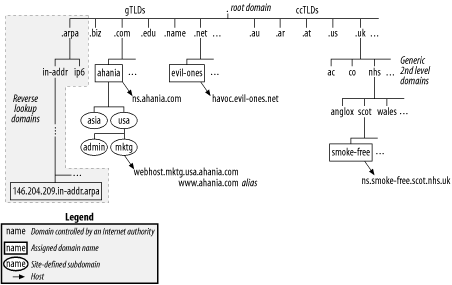Managing DNS Servers
The Domain Name System (DNS) is the facility that provides name resolution services.[1] This service consists of two distinct activities: the actual hostname-to-IP address translation process and distribution mechanisms for the underlying translation data. Structurally, DNS is a distributed database whose contents are spread across the entire Internet, with individual DNS servers permanently storing only the subset of data for which they are responsible. Queries into this massively distributed database work because DNS has the ability to forward translation requests to the appropriate server automatically, in a manner that scales extremely well. The total amount of DNS data is also referred to as theDNS namespace.
The DNS organizational structure defines thedomain name hierarchy familiar to most Internet users (see Figure 8-1). Domain names are arranged within a tree structure rooted at the root domain, which is designated by a single dot: “.”. Underneath the root domain are a series of top-level domains (TLDs) whose names take one of two forms: generic suffixes loosely indicating organization type (gTLDs) or two-character country codes (ccTLDs). The currently defined generic TLDs are summarized in Table 8-1 (see http://www.icann.org/tlds/ for up-to-the-minute information).

Figure 8-1. The DNS namespace
Table 8-1. Generic TLDs
gTLD | Current use |
|---|---|
| .com | Commercial entity ... |
Get Essential System Administration, 3rd Edition now with the O’Reilly learning platform.
O’Reilly members experience books, live events, courses curated by job role, and more from O’Reilly and nearly 200 top publishers.

